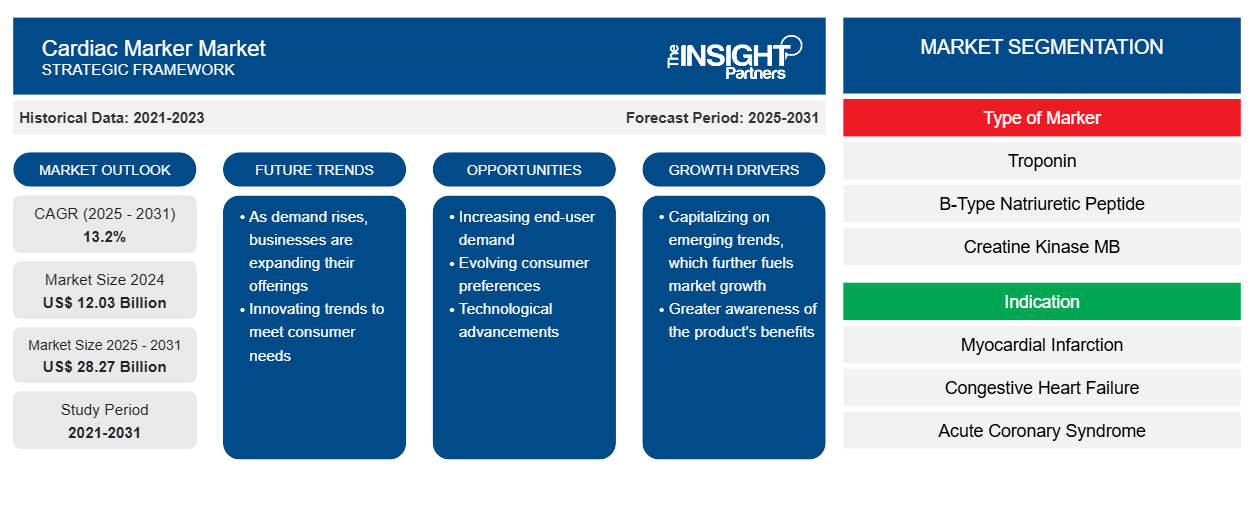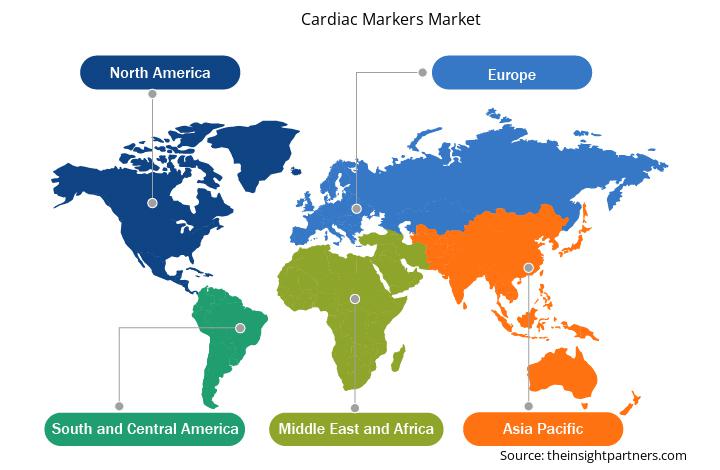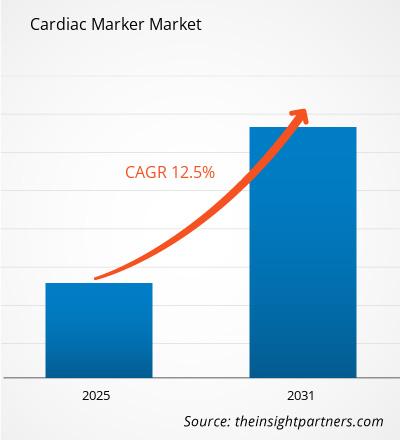[調査レポート] 心臓マーカー市場規模は、2024年の120.3億米ドルから2031年には282.7億米ドルに成長すると予測されており、2025年から2031年の間に13.2%のCAGRを記録すると予測されています。
市場洞察とアナリストの見解:
心筋マーカーは、心筋に損傷やストレスが生じた際に血流中に放出される物質です。これらのマーカーは、様々な心臓疾患を特定し、モニタリングするために使用されます。これらのマーカーは血液検査で測定され、そのレベルは心臓の機能に関する重要な情報を提供します。心筋マーカーは、急性冠症候群などの様々な疾患の迅速かつ正確な診断と治療、そして予後予測において非常に重要です。世界的な人口高齢化と心血管疾患(CVD)の発症率の増加に伴い、早期診断とリスク評価を容易にする、高感度かつ特異性の高い心筋マーカー検査の需要が高まっています。さらに、人工知能(AI)と機械学習アルゴリズムを心筋マーカー分析に組み込むことで、予測精度と個別化治療アプローチが向上します。心筋バイオマーカー分野における技術進歩は、心筋バイオマーカー業界に魅力的な機会をもたらしています。
成長の原動力:
世界保健機関(WHO)によると、CVDは世界中で罹患率と死亡率の主な原因となっています。CVDには、冠動脈性心疾患、心臓発作、心筋虚血などが含まれます。喫煙、糖尿病、肥満、生活習慣の変化といった様々な要因により、CVDの負担は世界中で増加しています。CVDに関連するその他の危険因子としては、高血圧、コレステロール値の上昇、糖尿病などが挙げられます。心臓発作や脳卒中は、一般的に脂肪沈着物が血管を塞ぎ、心臓や脳への血流を阻害することによって引き起こされます。様々なCVDの罹患率の増加に伴い、診断方法の改善が求められています。
世界心臓連盟(World Heart Federation)のプロジェクトが発表した報告書によると、世界中で5億人以上がCVDを患っており、2021年には2,050万人が死亡すると予測されています。WHOによると、毎年1,790万人がCVDで亡くなっており、これは世界全体の死亡者の32%に相当します。米国心臓協会(AHA)によると、米国の成人のほぼ半数が何らかのCVDを患っており、米国では死亡者の5人に1人がCVDによるものです。2035年までに、米国人口の45.1%にあたる1億3,000万人以上が何らかのCVDを患うと予測されています。
WHOによると、毎年約3,000万人が脳卒中を経験しています。米国疾病対策センター(CDC)によると、40秒ごとに1人のアメリカ人が心臓発作を起こしています。毎年約80万5,000人のアメリカ人が心臓発作を起こし、そのうち約60万5,000人が初めての発作です。Million Hearts 2021のデータによると、米国では毎年約150万件の心臓発作(心筋梗塞)と脳卒中が発生しています。CDCの2022年の推定によると、米国の成人2,010万人が冠動脈疾患を患っています。さらに、欧州心臓病学会は、心房細動の患者は脳卒中になるリスクが5倍高く、米国における脳卒中症例全体の20~30%は心房細動が原因であると報告しています。
心血管疾患の発生率の上昇は、正確かつタイムリーな診断を必要としています。事前モニタリングと事前診断により、ほとんどの種類のCVDを予防できます。バイオマーカーとは、特定の心血管疾患において血中に放出される特定の内因性物質であり、心機能の異常を示唆します。したがって、心血管マーカーの使用は、個人が心血管異常を検出するのに役立ちます。したがって、心血管疾患の増加は、予測期間中の心血管マーカー市場の成長を牽引するでしょう。
このレポートの一部、国レベルの分析、Excelデータパックなど、あらゆるレポートを無料でカスタマイズできます。また、スタートアップや大学向けのお得なオファーや割引もご利用いただけます。
心臓マーカー市場:戦略的洞察

- このレポートの主要な市場動向を入手してください。この無料サンプルには、市場動向から見積もりや予測に至るまでのデータ分析が含まれます。
レポートのセグメントと範囲:
世界の心臓マーカー市場は、マーカーの種類、適応症、エンドユーザー、および地域に基づいて区分されています。マーカーの種類に基づいて、市場はトロポニン、b型ナトリウム利尿ペプチド、クレアチンキナーゼMB、ミオグロビン、その他に分類されています。適応症に基づいて、市場はうっ血性心不全、心筋梗塞、急性冠症候群、その他に分類されています。エンドユーザーの観点から、心臓マーカー市場は病院、診断ラボ、ポイントオブケア検査施設、その他に分類されています。心臓マーカー市場は、地域に基づいて、北米(米国、カナダ、メキシコ)、欧州(ドイツ、フランス、イタリア、英国、スペイン、その他欧州)、アジア太平洋(オーストラリア、中国、日本、インド、韓国、その他アジア太平洋)、中東およびアフリカ(南アフリカ、サウジアラビア、UAE、その他中東およびアフリカ)、および南米および中米(ブラジル、アルゼンチン、その他南米および中米)に分類されています。
セグメント分析:
心臓マーカー市場は、マーカーの種類別に、トロポニン、b型ナトリウム利尿ペプチド、クレアチンキナーゼMB、ミオグロビンなどに分類されています。トロポニンセグメントは2022年に市場の大きなシェアを占めました。トロポニンは、心筋と骨格筋の収縮に必要なタンパク質です。心臓トロポニン検査は、血液中のトロポニンT(TnT)またはトロポニンI(TnI)タンパク質のレベルを測定します。これらのタンパク質は、心臓発作中など、心筋が損傷した場合にのみ血液中に現れます。心臓トロポニン検査は、心筋の損傷を検出します。心筋の損傷が大きいほど、血中のトロポニンレベルが高くなります。心臓トロポニンは、これまでのところ最も一般的に使用されているバイオマーカーであり、最も高い感度が知られています。トロポニンは、CVDの診断と管理において大きな進歩です。心筋細胞が損傷を受けると、これらの高度に特殊化したタンパク質が血流中に放出されます。トロポニンバイオマーカーは、心疾患の診断、心疾患の重症度の評価、適切な治療方針の選択、そして患者の転帰予測に不可欠です。さらに、高感度トロポニン測定は、血中微量のトロポニンを検出することで、臨床症状がない場合でも心臓異常を早期に診断する能力をさらに向上させます。
適応症に基づいて、心臓マーカー市場は、心筋梗塞、うっ血性心不全、急性冠症候群、その他に分類されます。急性冠症候群セグメントは、高所得国と比較して低・中所得国での疾病負担の増大により、2022年に大きな市場シェアを占めました。座りがちな労働の増加や急速な都市化などの要因が、疾患の発生率を押し上げています。心筋トロポニンTおよびIバイオマーカーの検査は、疾患診断における主要な診断方法となっています。冠動脈性心疾患の早期発見のための統合エピジェネティック遺伝子血液検査であるPrecisionCHDは、2023年2月にCardio Diagnosticsによって導入されました。この検査では、ゲノムおよびエピゲノムデータ、ならびに遺伝子バイオマーカーおよびエピジェネティクスを分析する機械学習モデルが活用されています。この技術は、患者のバイオマーカープロファイルを、喫煙、糖尿病、高血圧、高コレステロールなど、冠動脈疾患の重要な要因となる修正可能なリスク因子と関連付けます。しかし、心筋梗塞セグメントは、2022年から2031年にかけて市場で最も高いCAGRを記録すると予想されています。
エンドユーザーに基づいて、心血管マーカー市場は病院、診断ラボ、ポイントオブケア検査施設、その他に分類されます。病院セグメントは2022年に大きな市場シェアを占めました。病院は、患者数が多く、高度な診断施設が整備されていることから、最大のシェアを占めています。救急外来から入院治療に至るまで、心血管バイオマーカーは急性心血管イベントの診断、患者のリスク特定、そして治療決定の判断材料として不可欠です。これらのバイオマーカーの存在と正確な解釈は、医療従事者がタイムリーな介入を行い、患者の転帰を向上させることを可能にします。
地域分析:
地域別に見ると、心血管マーカー市場は主に北米、ヨーロッパ、アジア太平洋、中南米、中東・アフリカに分かれています。北米は2022年に世界市場で大きなシェアを獲得しました。北米における心血管マーカー市場の成長は、CVDを含む心疾患の発生率の増加、CVD診断の研究開発費の増加、そして医療インフラの整備に起因しています。2022年には、米国がこの地域で最大の市場シェアを占めました。
心臓病・脳卒中統計ファクトシート2022によると、米国では40秒ごとに1人が心筋梗塞を発症すると予想されています。同様に、CDC(疾病対策センター)の2021年9月の報告書によると、米国では40歳以上の約650万人が末梢動脈疾患を患っています。米国心臓協会によると、米国では34秒ごとに1人がCVDで亡くなっています。2021年には、米国で約69万7000人が心臓病で亡くなりました。これは、死亡者の5人に1人に相当します。また、カナダ心臓・脳卒中財団の2022年2月の報告書によると、米国では約75万人が心不全を患っており、年間10万人が心不全と診断されています。同様に、国立健康統計センターによると、2023年2月時点で、米国では2021年に約695,000人が心臓病で亡くなっています。米国では年間約150万件の心臓発作と脳卒中が発生しています。
米国におけるCVD(心血管疾患)の罹患率の増加は、高血圧、高コレステロール、低HDLコレステロール、肥満、糖尿病、腹部肥満、喫煙といったリスク要因の増加に起因すると考えられています。米国では、心臓病による医療費は年間約2,190億ドルに上ります。この総費用には、医療サービス、薬剤、そして早期死亡の費用が含まれます。
さらに、この地域では、革新的で技術的に高度な心筋マーカー検査および機器を導入しようとする市場プレーヤーの戦略が拡大しており、市場の成長に貢献すると予想されます。2021年7月、ベックマン・コールターは、うっ血性心不全治療用のベックマン・コールター製分析装置向けBNPアッセイの製造、流通、販売に関するすべての権利を取得する正式契約をQuidel Corporationと締結しました。したがって、上記の要因は、この地域の市場の成長に貢献すると予想されます。
業界の発展と将来の機会:
主要プレーヤーによる様々な取り組み世界の心臓マーカー市場の概要は以下の通りです。
- 2021年7月、ベックマン・コールターはQuidel Corporationと、ベックマン・コールターの分析装置向けBNPアッセイの製造、流通、販売に関するすべての権利を取得する正式契約を締結しました。契約条件に基づき、Quidelは引き続き本アッセイに関連する特定のコンポーネントを製造し、ベックマン・コールターに供給します。ベックマン・コールターは、Access BNPというブランド名で、本アッセイを独占的に製造・販売しています。
- 2021年4月、F. ホフマン・ラ・ロシュは、主要な心臓バイオマーカー(cTnT-hs)とElecsysテクノロジーを組み合わせた5つの新たなアプリケーションシリーズを発表しました。これらのバイオマーカーはCVD管理において有効性が実証されており、臨床医が心臓発作を診断し、心不全を管理するのに役立ちます。これにより、リスクの特定と診断が向上し、既存製品からの収益拡大につながります。
競争環境と主要企業:
心臓バイオマーカー市場で活動している著名な企業には、アボット・ダイアグノスティックス、ロシュ・ダイアグノスティックス、ビオメリューSA、サーモフィッシャーサイエンティフィック社、ベックマン・コールター社(ダナハー社)、バイオ・ラッド・ラボラトリーズ社、トリニティ・バイオテック社、クリエイティブ・ダイアグノスティックス社、ディアザイム・ラボラトリーズ社、シーメンス社、クイデル社などがあります。これらの企業は、世界中で高まる消費者需要を満たすため、新しいハイテク製品の導入、既存製品の改良、地理的拡大に注力しています。心臓バイオマーカー市場の企業は、世界市場での地位を維持し、専門ポートフォリオの製品範囲を拡大するために、コラボレーション、製品発売、事業拡大、契約など、さまざまな成長戦略を重視しています。これらの企業は世界中に広く展開しており、これにより多くの顧客にサービスを提供でき、その結果、心臓マーカー市場シェアを拡大しています。
レポートの範囲
心臓マーカー市場の地域別分析
Insight Partnersのアナリストは、予測期間全体を通して心筋マーカー市場に影響を与える地域的な動向と要因を詳細に解説しています。このセクションでは、北米、ヨーロッパ、アジア太平洋、中東・アフリカ、中南米における心筋マーカー市場のセグメントと地域についても解説します。

- 心臓マーカー市場の地域別データを入手
心臓マーカー市場レポートの範囲
| レポート属性 | 詳細 |
|---|---|
| 2024年の市場規模 | 120億3000万米ドル |
| 2031年までの市場規模 | 282億7000万米ドル |
| 世界のCAGR(2025年~2031年) | 13.2% |
| 履歴データ | 2021-2023 |
| 予測期間 | 2025~2031年 |
| 対象セグメント | マーカーの種類別
|
| 対象地域と国 | 北米
|
| 市場リーダーと主要企業の概要 |
|
心臓マーカー市場のプレーヤー密度:ビジネスダイナミクスへの影響を理解する
心臓マーカー市場は、消費者の嗜好の変化、技術の進歩、製品ベネフィットに対する認知度の高まりといった要因によるエンドユーザーの需要増加に牽引され、急速に成長しています。需要の増加に伴い、企業は製品ラインナップの拡充、消費者ニーズへの対応のための革新、そして新たなトレンドの活用を進めており、これが市場の成長をさらに加速させています。
市場プレーヤー密度とは、特定の市場または業界内で事業を展開する企業または会社の分布を指します。これは、特定の市場空間における競合企業(市場プレーヤー)の数が、その市場規模または市場価値全体と比較してどれだけ多いかを示します。
心臓マーカー市場で事業を展開している主要企業は次のとおりです。
- アボット・ダイアグノスティックス
- ロシュ・ダイアグノスティックス
- ビオメリューSA
- サーモフィッシャーサイエンティフィック株式会社
- ベックマン・コールター社(ダナハー)
- バイオ・ラッド・ラボラトリーズ
免責事項:上記の企業は、特定の順序でランク付けされているわけではありません。

- 心臓マーカー市場のトップキープレーヤーの概要を入手
- 過去2年間の分析、基準年、CAGRによる予測(7年間)
- PEST分析とSWOT分析
- 市場規模価値/数量 - 世界、地域、国
- 業界と競争環境
- Excel データセット
最新レポート
お客様の声
購入理由
- 情報に基づいた意思決定
- 市場動向の理解
- 競合分析
- 顧客インサイト
- 市場予測
- リスク軽減
- 戦略計画
- 投資の正当性
- 新興市場の特定
- マーケティング戦略の強化
- 業務効率の向上
- 規制動向への対応




















 無料サンプルを入手 - 心臓マーカー市場
無料サンプルを入手 - 心臓マーカー市場